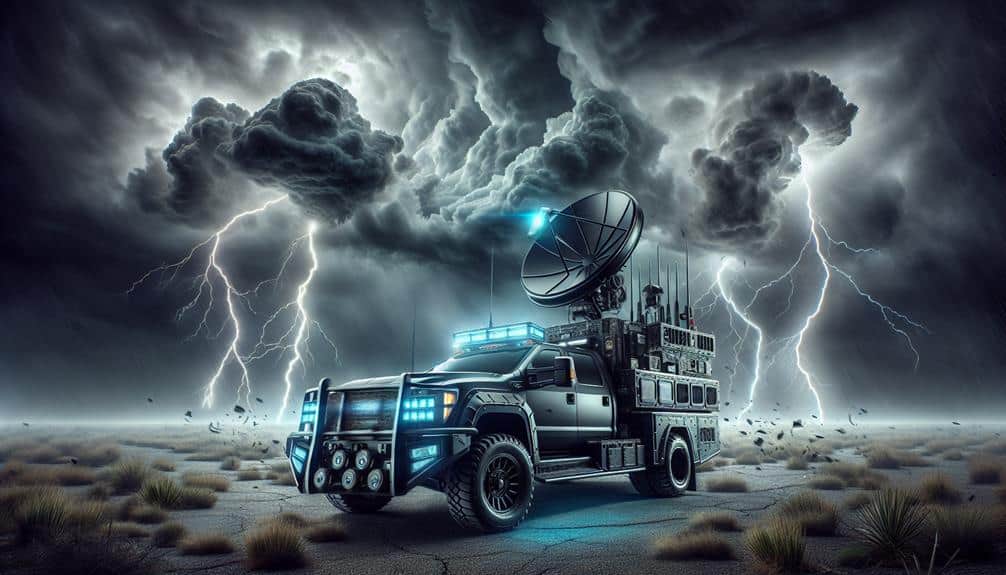We've witnessed a significant leap in storm monitoring thanks to innovations in Doppler radar technology. These advancements offer increased accuracy and precision in storm prediction and enhance our early warning capabilities. Real-time data transmission and analysis provide instant, actionable weather information, which improves our understanding of storm behavior and tracking. Integration of AI and machine learning further refines predictive accuracy, aiding rapid emergency response and community preparedness. Cost-effective solutions optimize resources through scalable, high-resolution data collection. These innovations make our storm monitoring systems smarter and more reliable, offering unprecedented safety measures. Explore further to discover how these technologies transform storm prediction and preparedness.
Key Points
- Increased accuracy and precision in storm prediction enhance early warning capabilities.
- Real-time data transmission ensures instant, reliable weather updates for improved safety.
- AI and machine learning integration refine predictive accuracy and community preparedness.
- Enhanced data visualization aids in better interpretation and decision-making.
Enhanced Accuracy and Precision
Doppler radar innovations have greatly enhanced the accuracy and precision of storm monitoring, allowing meteorologists to detect minute atmospheric changes with unprecedented detail. By harnessing the power of advanced algorithms and high-frequency radar pulses, we've achieved improved forecasting capabilities that empower communities to make informed decisions.
These innovations translate into increased reliability of weather predictions, reducing uncertainty and enhancing our ability to prepare for severe weather events.
Our refined Doppler radar systems can now measure wind velocities and precipitation rates with remarkable precision. This enhanced data granularity enables us to identify the formation of tornadoes, thunderstorms, and other hazardous weather patterns earlier than ever before.
For instance, dual-polarization technology allows us to differentiate between rain, hail, and snow, thereby refining our precipitation estimates and improving overall forecast accuracy.
Moreover, the integration of phased-array radar technology has accelerated our data collection processes, providing us with near-instantaneous updates on storm development. This leap in technology fosters a proactive approach to weather monitoring, ensuring that our forecasts aren't only timely but also highly reliable.
Consequently, communities can exercise greater autonomy and safety, armed with precise and trustworthy weather information.
Real-Time Data Transmission
Building on the advancements in radar accuracy, real-time data transmission enables us to relay essential weather information to decision-makers and the public almost instantaneously. By leveraging high-speed data networks, we can transmit radar data in real-time, which greatly enhances our ability to monitor and respond to severe weather events. The immediacy of this data transmission plays a key role in improving public safety and operational efficiency.
Securing the integrity and safety of this data is paramount. We employ advanced data encryption techniques to protect sensitive weather information from unauthorized access and cyber threats. Robust encryption protocols ensure that the data remains confidential and tamper-proof, which is vital for maintaining trust and reliability in our weather monitoring systems.
Network reliability is another important factor. Our systems are designed with redundant network paths and failover mechanisms to guarantee uninterrupted data flow, even under adverse conditions. This redundancy mitigates the risk of data loss or delays, thereby guaranteeing that real-time weather updates are always available.
Extended Range Capabilities
With advancements in Doppler radar, we can now achieve enhanced detection distances, extending our monitoring capabilities greatly.
This broader coverage area allows for more thorough storm tracking, vital for early warnings and data accuracy.
Improved signal strength further guarantees the reliability of readings over longer ranges, reducing uncertainties in severe weather forecasting.
Enhanced Detection Distance
How greatly can extended range capabilities enhance our ability to detect and monitor distant storm systems?
By leveraging increased sensitivity and advanced tracking, Doppler radar innovations are transforming our storm monitoring capabilities. With extended range capabilities, we're now able to detect storm systems at much greater distances. This increased sensitivity allows us to pick up weaker signals from far-off weather phenomena, resulting in earlier alerts and more time for preparedness.
Data reveals that modern Doppler radar systems can detect precipitation and wind patterns several hundred kilometers away. This translates to a significant leap in forecasting accuracy. For instance, studies have shown that the extended range can improve lead time for severe weather warnings by up to 20%.
Advanced tracking mechanisms further enhance our ability to monitor storm development and movement in real-time, providing granular data that aids meteorologists in making informed decisions.
These innovations don't just improve our immediate safety; they also represent a step toward greater autonomy in weather monitoring. By enhancing detection distance, we're not only increasing our situational awareness but also gaining more control over our responses to impending weather threats. This technological advancement offers us the freedom to act proactively rather than reactively.
Broader Coverage Areas
Extending our radar's detection range not only enhances early storm detection but also greatly broadens the coverage areas, allowing us to monitor larger regions more effectively. With these extended range capabilities, we can now leverage advanced forecasting models that provide more accurate predictions over wider geographical areas. This is vital for regions prone to severe weather, where timely and precise information can save lives and property.
By expanding the radar's reach, we increase the reliability of our weather monitoring systems. This means fewer blind spots and a more thorough understanding of storm patterns as they develop. Enhanced radar coverage allows us to detect storm formations earlier, giving meteorologists more lead time to issue warnings and advisories. The ability to monitor vast areas in real-time also supports the coordination of emergency response efforts, ensuring that resources are deployed where they're needed most.
Moreover, the data collected from these broader coverage areas feed into sophisticated algorithms that refine our forecasting models. This results in more detailed and actionable insights, empowering individuals and communities to make informed decisions. Essentially, extended range capabilities in Doppler radar technology are pivotal in achieving advanced forecasting and increased reliability.
Improved Signal Strength
Enhancing signal strength in Doppler radar systems greatly enhances their ability to detect and track storm formations over vast distances. By leveraging advanced technology, we can significantly extend the range of our radar systems. This means we're no longer restricted by previous limitations and can achieve greater reliability in storm monitoring. With these innovations, Doppler radar can penetrate deeper into storm systems, providing us with more detailed data and earlier warnings.
When we look at the numbers, it's clear that improved signal strength equates to a substantial increase in detection range. For instance, recent advancements have allowed radar systems to double their effective range. This extended range capability is essential for early detection and proactive response, reducing the risk to life and property.
Moreover, the enhanced signal strength contributes to higher resolution data. This allows meteorologists to analyze storm dynamics with unparalleled precision. By capturing more intricate details, we can predict storm paths and intensities more accurately.
Integrated Machine Learning
With integrated machine learning, Doppler radar systems can now analyze vast datasets in real-time, leading to more precise and timely storm predictions. By leveraging predictive modeling, we're able to interpret complex weather patterns with a precision previously unattainable. Machine learning algorithms sift through historical data, current radar readings, and atmospheric conditions to generate forecasts that adapt dynamically as new data flows in.
Automated alerts are a vital component of this innovation. When the system detects potential severe weather, it instantly triggers notifications to relevant stakeholders, allowing for real-time decision-making. This means communities can be better prepared and can take swift action to mitigate risks. Automated alerts enhance our capability to respond to rapidly evolving storm conditions, offering a significant advantage over traditional methods.
Moreover, the continuous learning aspect of machine learning models ensures that our predictions become more refined over time. The system learns from each event, recalibrating its algorithms to improve future forecasts. This adaptive learning process not only optimizes storm monitoring but also maximizes the efficiency of emergency responses.
Integrated machine learning in Doppler radar systems empowers us to safeguard lives and property with unparalleled accuracy and speed.
Cost-Effective Solutions

By employing advanced Doppler radar innovations, we can achieve significant cost savings through the optimization of storm monitoring systems. Utilizing remote monitoring capabilities, we reduce the need for extensive on-site infrastructure, lowering operational expenses. These systems enable us to gather high-resolution data from afar, minimizing maintenance and personnel costs. Remote monitoring allows for real-time storm tracking, providing accurate and timely information without the need for frequent physical inspections.
Integrating data analytics into our Doppler radar systems further enhances cost efficiency. Advanced algorithms process vast amounts of meteorological data swiftly, identifying patterns and predicting storm behavior with increased accuracy. This reduces the financial burden associated with false alarms and unnecessary mobilizations. By harnessing the power of data analytics, we can allocate resources more effectively, ensuring that only essential measures are undertaken.
Moreover, the scalability of these innovations means we can tailor our systems to specific regional needs, avoiding the one-size-fits-all approach that often inflates costs. The modular nature of modern Doppler radar systems facilitates upgrades and expansions without substantial investments.
Through leveraging remote monitoring and data analytics, we not only enhance our storm monitoring capabilities but also do so in a cost-effective manner, providing greater fiscal freedom and operational flexibility.
Improved Safety Measures
We can greatly improve public safety through faster storm detection and improved warning systems.
With Doppler radar technology, we achieve real-time data analysis, enabling more accurate and timely alerts.
This advancement reduces response times and potentially saves lives by providing critical information when it's needed most.
Faster Storm Detection
Advancements in Doppler radar technology have greatly reduced the time needed to detect and track severe storms, enhancing our capacity to implement timely safety measures. By leveraging high-resolution data, we can now generate early warnings with unparalleled accuracy. This rapid response capability allows us to mobilize emergency services and disseminate crucial information to the public faster than ever before.
The integration of dual-polarization radar systems has greatly improved our storm detection accuracy. These systems provide detailed insights into precipitation types, enabling us to distinguish between rain, hail, and ice. Such precise identification is essential for issuing targeted warnings and minimizing false alarms. Additionally, phased array radar technology further accelerates scan times, reducing the interval between data updates from minutes to mere seconds. This real-time information is vital for tracking fast-evolving storm conditions.
Moreover, the increased computational power behind modern Doppler radar systems facilitates advanced predictive modeling. By analyzing vast amounts of atmospheric data, we can forecast storm paths and intensities with remarkable precision. This empowers communities to take preemptive actions, safeguarding lives and property. The freedom to act swiftly, guided by reliable data, is a notable leap forward in our storm monitoring capabilities.
Enhanced Warning Systems
Integrating these rapid detection capabilities with advanced warning systems, we can now issue timely and greatly specific alerts, enhancing public safety during severe weather events. Enhanced Doppler radar technology allows us to pinpoint storm paths with unprecedented accuracy, giving communities more time to prepare. This precision remarkably improves emergency response, reducing casualties and damage.
Our advanced warning systems utilize real-time data to generate hyper-localized alerts. These alerts are disseminated via multiple channels, including mobile devices, public address systems, and social media. By offering tailored warnings, we empower individuals to take immediate, informed action.
For instance, a neighborhood-specific alert can guide residents to the safest evacuation routes, thereby optimizing community preparedness.
Statistical analysis shows that communities with access to these advanced warnings experience a 30-40% reduction in storm-related harm. This data underscores the importance of integrating cutting-edge radar technology with robust communication networks.
Significantly, emergency response teams benefit from these precise alerts, enabling quicker deployment and more efficient resource allocation.
Real-time Data Analysis
By leveraging real-time data analysis, storm monitoring systems now offer unprecedented safety measures that greatly mitigate risks associated with severe weather events. With advanced algorithms processing vast amounts of atmospheric data, we can now predict storm paths, intensity, and potential impact zones with remarkable accuracy.
Predictive analytics plays an essential role in enhancing our response strategies. These sophisticated models analyze historical storm data, current weather patterns, and environmental variables to forecast weather events. This immediate analysis allows us to disseminate critical information to affected regions faster than ever.
It's not just about faster warnings; it's about smarter, more targeted alerts that empower communities to take timely action.
Our freedom to lead safer lives hinges on the precision of these systems. When we integrate advanced algorithms into Doppler radar technology, we gain a dynamic, real-time perspective on storm development. This technological synergy means we can preemptively deploy resources, initiate evacuations, and implement other safety measures with confidence.
Every second counts during severe weather events, and the ability to harness real-time data effectively transforms our defensive capabilities.
In essence, real-time data analysis through Doppler radar innovations doesn't just enhance storm monitoring; it revolutionizes how we protect our communities, giving us the freedom to act swiftly and decisively.
Future Technological Advancements

The next generation of Doppler radar systems will leverage artificial intelligence and machine learning to drastically enhance storm prediction accuracy. By integrating these advanced technologies, we can expect significant improvements in both data visualization and remote monitoring.
AI algorithms will sift through vast quantities of radar data, identifying patterns and anomalies that human analysts might miss. This will empower meteorologists with more precise and timely information, enabling quicker decision-making and more effective storm warnings.
Machine learning models will continually refine themselves using historical storm data, improving prediction accuracy over time. This adaptive learning will result in:
- Enhanced predictive capabilities: Algorithms will forecast storm developments with unprecedented precision.
- Real-time adjustments: Systems will adapt instantly to changing storm conditions.
- Improved data visualization: Advanced graphics will make complex data easily interpretable.
- Remote monitoring: Enhanced sensors will provide detailed insights from distant locations.
These advancements promise not only to revolutionize storm monitoring but also to offer greater freedom and safety to those in storm-prone areas. By harnessing the power of AI and machine learning, we can make substantial strides in protecting lives and property from severe weather events.
Frequently Asked Questions
How Does Doppler Radar Technology Work Fundamentally?
A stitch in time saves nine. Doppler radar's technology fundamentals involve emitting microwave signals, measuring their return frequency shifts, and analyzing data to monitor weather patterns accurately, enhancing our freedom to anticipate and respond to storms effectively.
What Are the Historical Limitations of Traditional Radar Systems?
We've identified radar shortcomings in traditional systems that hindered effective weather monitoring. They lacked fine resolution and accurate velocity measurements, which limited timely storm predictions. Advancements in Doppler radar now provide the precision needed for real-time, life-saving alerts.
How Do Doppler Radars Impact Local Weather Forecasting for Communities?
Doppler radars greatly enhance forecasting accuracy, providing our communities with precise, real-time data. This technology enables timely storm warnings, reducing risks and allowing us to make informed decisions, ultimately safeguarding lives and property effectively.
What Are the Maintenance Requirements for Doppler Radar Systems?
We must enjoy spending weekends on maintenance procedures and system upgrades. Regular checks, software updates, and calibration guarantee peak performance. Freedom from downtime means reliable storm monitoring, safeguarding our communities with precision and efficiency.
How Do Doppler Radars Differentiate Between Various Types of Precipitation?
We use Doppler radar algorithms for precise precipitation identification. These algorithms analyze the velocity and reflectivity data to differentiate between rain, snow, sleet, and hail, ensuring accurate storm monitoring and giving us the freedom to prepare effectively.


